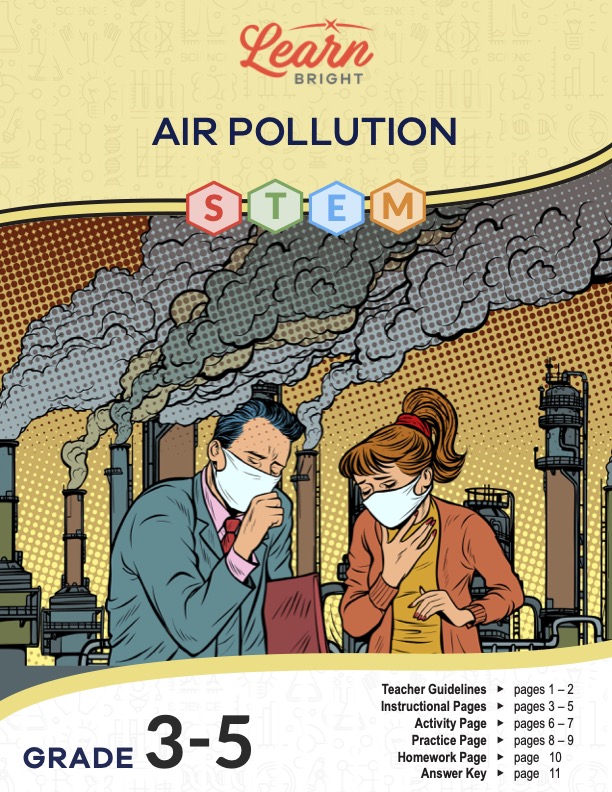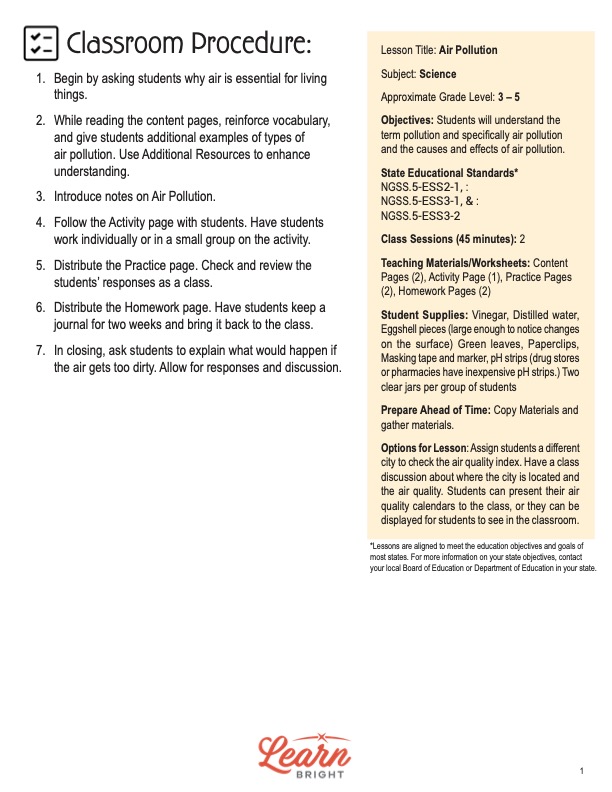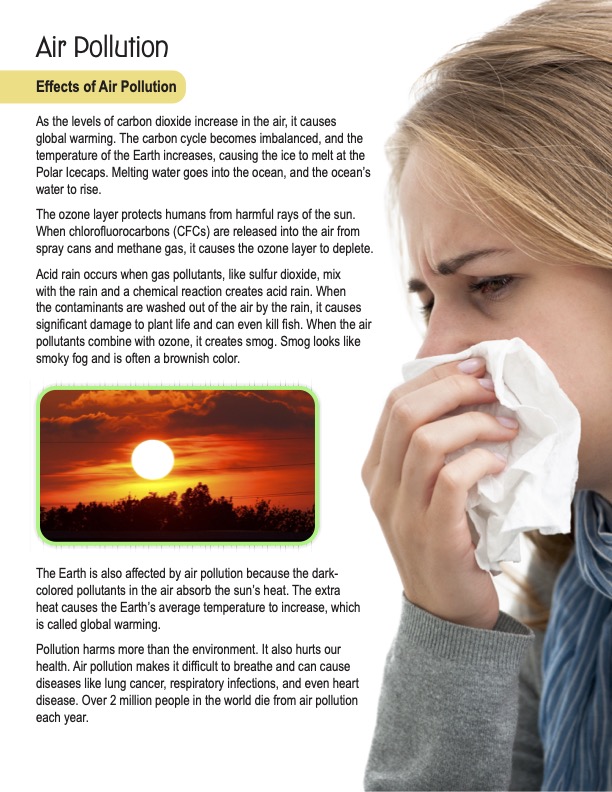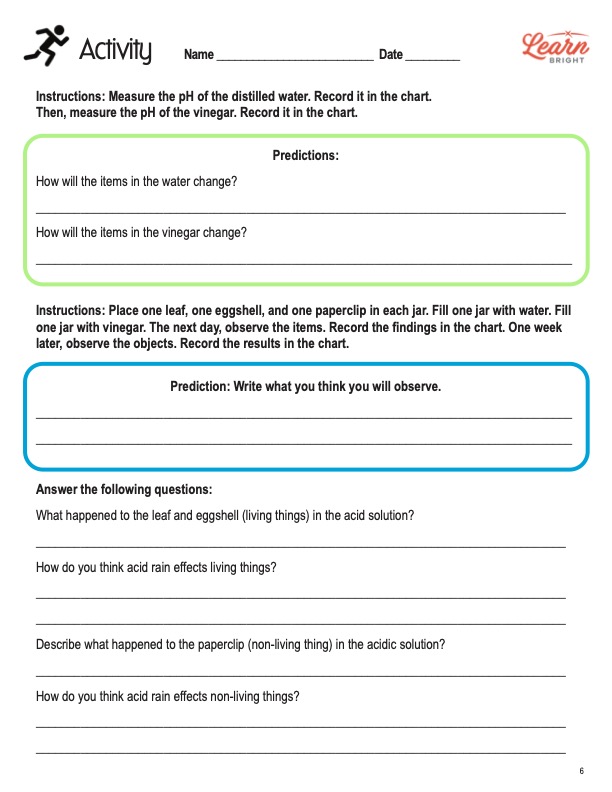Description
What our Air Pollution STEM lesson plan includes
Lesson Objectives and Overview: Air Pollution STEM teaches students about the things that can make the air quality worse. Students will learn about the term pollution and discuss the causes and effects of pollutants in the air. This lesson is for students in 3rd grade, 4th grade, and 5th grade.
Classroom Procedure
Every lesson plan provides you with a classroom procedure page that outlines a step-by-step guide to follow. You do not have to follow the guide exactly. The guide helps you organize the lesson and details when to hand out worksheets. It also lists information in the yellow box that you might find useful. You will find the lesson objectives, state standards, and number of class sessions the lesson should take to complete in this area. In addition, it describes the supplies you will need as well as what and how you need to prepare beforehand. The supplies you need for this lesson are vinegar, distilled water, eggshell pieces, green leaves, paperclips, masking tape, markers, pH strips, and two clean jars per student.
Options for Lesson
You may choose to incorporate some of the suggestions in the “Options for Lesson” section of the classroom procedure page. One suggestion is to assign students different cities for which they can check the air quality index. The class can then discuss each city and its air quality. Another option is for students to present their air quality calendars to the class. You could also display them on the walls for students to observe.
Teacher Notes
The teacher notes page provides an extra paragraph of information to help guide the lesson and remind you what to focus on. It explains that the focus of this lesson is on the causes of air pollution. The blank lines on this page are available for you to write out thoughts and ideas you have as you prepare the lesson.
AIR POLLUTION STEM LESSON PLAN CONTENT PAGES
Causes
The Air Pollution STEM lesson plan contains a total of three content pages. To start off, the lesson explains that pollution in the air occurs when pollutants get stuck in the atmosphere. These pollutants can be solid, liquid, or gas particles that hang around in the air. They can come from either natural or manmade sources.
The lesson lists three types of natural sources from which pollutants can originate, which are volcanoes, wildfires, and mold spores. There are also three human-made pollutants on the chart: factories, car or vehicle exhaust, and the burning of coal or oil. There are many more examples, and you could ask the class if they can think of other sources, either natural or manmade.
Many different things can cause air pollution. They fall into the same categories as the types of pollutants: natural or human. Natural causes include dust storms, volcanoes, and forest fires. Human causes include airplanes, spray cans, and landfills. Burning fossil fuels releases gases into the air that cause pollution. The most familiar type of pollution from this source is smog.
Effects
Unsurprisingly, there are many detrimental effects of pollution on the environment. As the levels of carbon dioxide increase in the atmosphere, we experience global warming. The carbon cycle becomes imbalanced, and Earth’s global temperature increases. This causes the ice to melt at the polar icecaps. That water flows into the ocean, which causes the water levels to rise.
Another problem with air pollution involves the ozone layer that protects us from the sun’s harmful rays. When something called chlorofluorocarbons (CFCs) enter the air from spray cans and methane gas, they deplete the ozone layer. Acid rain is another harmful effect. This occurs when gas pollutants like sulfur dioxide mix with the rain. The resulting chemical reaction creates acid rain. When rain washes the contaminants out of the air, it can cause significant damage to both plant and animal life, sometimes even killing fish.
Students will discover that smog results from pollutants combining with the ozone layer. It looks like smoky fog and is often a brownish color. The Earth itself is affected by air pollution because the dark-colored pollutants absorb the sun’s heat. Extra heat also causes the Earth’s average temperature to increase.
AIR POLLUTION STEM LESSON PLAN WORKSHEETS
The Air Pollution STEM lesson plan includes three worksheets: an activity worksheet, a practice worksheet, and a homework assignment. Each one will reinforce students’ comprehension of lesson material in different ways and help them demonstrate when they learned. Use the guidelines on the classroom procedure page to determine when to distribute each worksheet to the class.
OBSERVATION CHART ACTIVITY WORKSHEET
For the activity, students will predict the effects of acid on various materials. First, they will record their predictions about how objects will change in water and how they will change in vinegar. They will then predict what they think will happen over the course of a week. The second worksheet page is an observation chart on which to record their observations every day. After a week, students will answer the four questions on the first worksheet page.
AIR POLLUTION STEM PRACTICE WORKSHEET
The practice worksheet includes a table and eight photos. The table has two columns, one for items that cause air pollution and one for items that do not. Students will cut out the eight photo squares and paste them in the correct column of the table.
AIR QUALITY HOMEWORK ASSIGNMENT
If you like, you can complete this assignment as a class. Students will record the air quality of their city every day for two weeks. They will use different colors to represent the air quality index, from green for good to brown for hazardous.
Worksheet Answer Keys
There are answer keys for the practice and homework worksheets. The correct answers are in red to make it easy to compare them with students’ responses. Given the nature of the homework assignment, however, answers will vary based on a number of variables. You will have to ensure you record the air quality index for the two required weeks to which you can compare students’ work. If you choose to administer the lesson pages to your students via PDF, you will need to save a new file that omits these pages. Otherwise, you can simply print out the applicable pages and keep these as reference for yourself when grading assignments.









